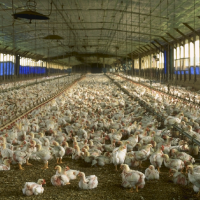Growth of Factory Farming Leading to Uncontrolled Problems of Animal Waste
 (photo: U.S. Department of Agriculture)
(photo: U.S. Department of Agriculture)
Large-scale agricultural operations involving livestock are turning into one of the most seriously uncontrolled environmental problems facing the United States.
These so-called factory farms produce enormous amounts of animal waste—in quantities so great that a single farm can surpass a major metropolitan city’s output of excrement.
Take Miami, Florida, for example. It has a human population of about 409,000. But a factory farm with 2,500 cows can equal Miami’s production of “fertilizer.”
Even more concerning is that the waste from really large factory farms, what the government calls “concentrated animal feeding operations” (CAFOs), is not treated. It simply gets dumped—either onto fields as fertilizer or stored in surface ponds that can grow into small lakes.
The problem with this storage is that when bad weather strikes, the ponds can overflow, causing millions of gallons of manure to drain into rivers or streams.
In 1995, a North Carolina pig farm spilled 25 million gallons of waste into a local waterway.
The waste can contain hormones, pathogens and toxic metals, according to the U.S. Environmental Protection Agency (EPA).
The EPA says about 75% of all CAFOs in the U.S. are causing pollution, even though only 45% of them have discharge permits from the government.
Today, there are approximately 20,000 CAFOs in the country, up from only 3,600 in 1982. The EPA defines a large CAFO as one with at least 700 dairy cows, 2,500 large pigs, 125,000 chickens raised for meat, 30,000 egg-laying hens of 1,000 beef cows. The states with the most large CAFOs are Iowa, Minnesota, North Carolina, Texas and California.
-Noel Brinkerhoff
To Learn More:
As Factory Farms Spread, Government Efforts to Curb Threat From Livestock Waste Bog Down (by Bridget Huber, Fair Warning)
Pollution from Giant Livestock Farms Threatens Public Health (Natural Resources Defense Council)
Risk Assessment Evaluation for Concentrated Animal Feeding Operations (U.S. Environmental Protection Agency) (pdf)
Animal Farms Get Bigger and Bigger (by Noel Brinkerhoff, AllGov)
- Top Stories
- Unusual News
- Where is the Money Going?
- Controversies
- U.S. and the World
- Appointments and Resignations
- Latest News
- Trump to Stop Deportations If…
- Trump Denounces World Series
- What If China Invaded the United States?
- Donald Trump Has a Mental Health Problem and It Has a Name
- Trump Goes on Renaming Frenzy






Comments